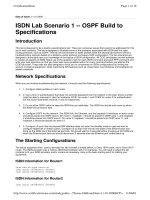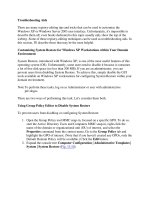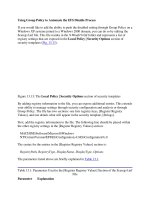Tài liệu Troubleshooting Frame Relay 1 docx
Bạn đang xem bản rút gọn của tài liệu. Xem và tải ngay bản đầy đủ của tài liệu tại đây (47.53 KB, 10 trang )
1-10 Semester 8 Internetwork Troubleshooting v1.0 - Lab 8.3.4.1 Copyright 2001, Cisco Systems, Inc.
Lab 8.3.4.1: Troubleshooting Frame Relay 1
Frame Relay
Atlas 550
192.168.192.0/24
1/2
2/1
S0/0 S0/0
DLCI 17 DLCI 18
.2
.4
Fa0/0 192.168.200.1/24 Fa0/0 192.168.232.1/24
London Singapore
Objective
Apply the troubleshooting method to a simple Frame Relay network problem.
Scenario
A new Frame Relay connection was installed between London and Singapore
over the weekend. On Monday, both network operators at London and
Singapore call to let you know they are unable to reach each other with this
new Frame Relay connection. You check connectivity between the London
router and the Singapore router and find you cannot ping or telnet between
the sites. It is your responsibility to get London and Singapore communicating.
Adtran Atlas 550 Note
If using the Adtran Atlas 550 as your Frame Relay switch, you will see
information about DLCIs (such as DLCI 16) that are not shown in sample
outputs of this lab. These DLCIs are configured on the Atlas 550, but are not
being used for this specific lab. You would not normally see these extra DLCIs
so any information pertaining to them should be disregarded for this lab.
Step 1
Cable the lab as shown in the diagram.
Load the configuration file called Lab8-3-4-1-LondonBrokenConfig.txt into
the London router. Load the file called Lab8-3-4-1-
SingaporeBrokenConfig.txt into the Singapore router.
2-10 Semester 8 Internetwork Troubleshooting v1.0 - Lab 8.3.4.1 Copyright 2001, Cisco Systems, Inc.
Step 2
Use ping and telnet to check connectivity between London and Singapore.
All ping and telnet attempts from either site to the other should fail. From
each router, ping its directly connected LAN interface. This ping should be
successful.
1. Define the problem you are experiencing.
Step 3
Gather the facts about the situation at hand. The commands listed below are
useful for gathering factual information about each router.
• show interfaces
• show frame-relay lmi
• show frame-relay pvc
• show frame-relay map
Gather information about the London router first. Console into the London
router and issue a show interfaces serial 0/0 command. The
highlighted information in the sample output below is useful for troubleshooting
and should be the same as the information in your output.
London#show interfaces serial 0/0
Serial0/0 is up, line protocol is up
Hardware is PowerQUICC Serial
Internet address is 192.168.192.2/24
MTU 1500 bytes, BW 128 Kbit, DLY 20000 usec,
reliability 255/255, txload 1/255, rxload 1/255
Encapsulation FRAME-RELAY, loopback not set
Keepalive set (10 sec)
LMI enq sent 152, LMI stat recvd 152, LMI upd recvd 0, DTE LMI up
LMI enq recvd 0, LMI stat sent 0, LMI upd sent 0
LMI DLCI 0 LMI type is ANSI Annex D frame relay DTE
Broadcast queue 0/64, broadcasts sent/dropped 33/0, interface broadcasts 20
Last input 00:00:01, output 00:00:01, output hang never
Last clearing of "show interface" counters 00:25:24
Input queue: 0/75/0 (size/max/drops); Total output drops: 0
Queueing strategy: weighted fair
Output queue: 0/1000/64/0 (size/max total/threshold/drops)
Conversations 0/1/32 (active/max active/max total)
Reserved Conversations 0/0 (allocated/max allocated)
5 minute input rate 0 bits/sec, 0 packets/sec
5 minute output rate 0 bits/sec, 0 packets/sec
3-10 Semester 8 Internetwork Troubleshooting v1.0 - Lab 8.3.4.1 Copyright 2001, Cisco Systems, Inc.
187 packets input, 8033 bytes, 0 no buffer
Received 0 broadcasts, 0 runts, 0 giants, 0 throttles
1 input errors, 0 CRC, 1 frame, 0 overrun, 0 ignored, 0 abort
185 packets output, 8366 bytes, 0 underruns
0 output errors, 0 collisions, 1 interface resets
0 output buffer failures, 0 output buffers swapped out
0 carrier transitions
DCD=up DSR=up DTR=up RTS=up CTS=up
Upon examining the output, everything looks fine here. Notice the output “LMI
DLCI 0.” If the LMI type is “ANSI,” as it is in this case or Q933a, DLCI 0 is used
for that local LMI usage. If the LMI type is “CISCO”, the DLCI would be 1023 for
local LMI purposes. This is good Support Exam knowledge.
Issue a show frame-relay lmi command on the London router. The
highlighted information in the sample output below is useful for troubleshooting
and should be similar to the information in your output.
London#show frame-relay lmi
LMI Statistics for interface Serial0/0 (Frame Relay DTE) LMI TYPE = ANSI
Invalid Unnumbered info 0 Invalid Prot Disc 0
Invalid dummy Call Ref 0 Invalid Msg Type 0
Invalid Status Message 0 Invalid Lock Shift 0
Invalid Information ID 0 Invalid Report IE Len 0
Invalid Report Request 0 Invalid Keep IE Len 0
Num Status Enq. Sent 16 Num Status msgs Rcvd 16
Num Update Status Rcvd 0 Num Status Timeouts 0
Notice that the router and Frame Relay switch are exchanging LMIs, “Num
Status Enq. Sent” and “Num Status msgs Rcvd.” When this is the case the
DLCI and LMI type are most likely configured correctly.
Issue a show frame-relay pvc command on the London router. The
highlighted information in the sample output below is useful for troubleshooting
and should be the same as the information in your output. (Remember to ignore
information about other DLCIs.)
London#show frame-relay pvc
PVC Statistics for interface Serial0/0 (Frame Relay DTE)
Active Inactive Deleted Static
Local 1 1 0 0
Switched 0 0 0 0
Unused 0 0 0 0
<output omitted>
DLCI = 17, DLCI USAGE = LOCAL, PVC STATUS = ACTIVE, INTERFACE = Serial0/0
input pkts 1 output pkts 11 in bytes 30
out bytes 3683 dropped pkts 0 in FECN pkts 0
in BECN pkts 0 out FECN pkts 0 out BECN pkts 0
in DE pkts 0 out DE pkts 0
out bcast pkts 11 out bcast bytes 3683
pvc create time 00:02:54, last time pvc status changed 00:02:54
4-10 Semester 8 Internetwork Troubleshooting v1.0 - Lab 8.3.4.1 Copyright 2001, Cisco Systems, Inc.
Notice the PVC for DLCI 17 is ACTIVE, which indicates that the PVC between
the router and the switch is configured correctly. If the PVC status was inactive,
it would most likely be a problem with the Frame Relay cloud or might also
indicate a configuration problem between the Frame Relay cloud and the
remote site.
Issue a show frame-relay map command on the London router. The
highlighted information in the sample output below is useful for troubleshooting
and should be the same as the information in your output. (Remember to ignore
information about other DLCIs.) Since everything else seems to be working
correctly, you should expect to see a successful mapping of London’s DLCI to a
remote IP address.
London#show frame-relay map
Serial0/0 (up): ip 0.0.0.0 dlci 16(0x10,0x400)
broadcast,
CISCO, status defined, active
Serial0/0 (up): ip 192.168.192.4 dlci 17(0x11,0x410), static,
broadcast,
CISCO, status defined, active
The DLCI has been successful mapped to the remote IP address via a “static”
frame-relay map statement. “CISCO” identifies the Frame Relay
encapsulation used with frame-relay map statement, which is the default
Frame Relay encapsulation on Cisco routers.
Listed below is a summary of pertinent factual information gathered about the
London router.
• The WAN interface serial 0/0 interfaces and line protocol are up; the
encapsulation is Frame-Relay; the LMI is up; and the LMI type is ANSI.
• LMIs are being sent and received so the router and Frame Relay switch are
exchanging LMIs.
• The PVC for DLCI 17 is active indicating the PVC between the router and
switch is configured correctly.
• The Frame Relay map is configured correctly.
So far there does not appear to be any configuration problems on the London
router. Now, gather information about the Singapore router.
Console into the Singapore router and issue a show interfaces serial
0/0 command.
2. What pertinent factual information about the interface did you gather and is
there any indication of a possible problem? (Hint: The information should
be the same as gathered for the London router.)
5-10 Semester 8 Internetwork Troubleshooting v1.0 - Lab 8.3.4.1 Copyright 2001, Cisco Systems, Inc.
Issue a show frame-relay lmi command.
3. What pertinent factual information about the LMI did you gather and is there
any indication of a possible problem? (Hint: The information should be the
same as gathered for the London router.)
Issue a show frame-relay pvc command.
4. What pertinent factual information about PVCs did you gather and is there
any indication of a possible problem? (Hint: The DLCI 17 PVC status
should be “deleted”.)
Note: If the DCLI status is INACTIVE it is usually a problem at the remote
router. If the DLCI is INACTIVE the service provider’s switch is programmed
to handle/forward frames that your router sends with that DLCI number, but
it is not aware/informed that your destination router is ready to receive them.
The destination router may be down, non-existent, or having Layer 1
problems. Also, if it is INACTIVE there might be an LMI type mismatch
between the local router and the Frame Relay switch.
Issue a show frame-relay map command.
5. What pertinent factual information about the frame-relay map did you
gather and is there any indication of a possible problem? (Hint: The status
should be “deleted”.)
Step 4
6. Examine the facts you have just gathered. Based on your observations,
what are the possible causes of the problem? (Hint: If the DLCI status is









